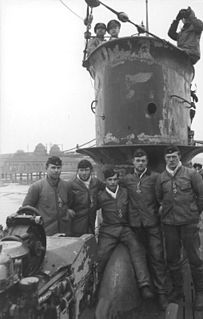 Although this photograph is undated, it was probably taken pre-war, as U-52's number, here visible on the conning tower, was painted out on the commencement of hostilities | |
| History | |
|---|---|
| Name: | U-52 |
| Ordered: | 15 May 1937 [1] |
| Builder: | Germaniawerft, Kiel |
| Cost: | 4,439,000 Reichsmark |
| Yard number: | 587 |
| Laid down: | 9 March 1937 [1] |
| Launched: | 21 December 1938 [1] |
| Commissioned: | 4 February 1939 [1] |
| Struck: | October 1943 |
| Fate: | Scuttled at Danzig, 3 May 1945, broken up, 1946-7 [1] |
| General characteristics | |
| Class and type: | Type VIIB U-boat |
| Displacement: |
|
| Length: |
|
| Beam: |
|
| Draught: | 4.74 m (15 ft 7 in) |
| Installed power: |
|
| Propulsion: |
|
| Range: |
|
| Test depth: |
|
| Complement: | 4 officers, 40–56 enlisted |
| Sensors and processing systems: | Gruppenhorchgerät |
| Armament: |
|
| Service record | |
| Part of: |
|
| Commanders: |
|
| Operations: |
|
| Victories: | Thirteen vessels sunk (56,333 GRT) |
German submarine U-52 was a type VIIB U-boat of Nazi Germany's Kriegsmarine during World War II. She was initially ordered on 15 May 1937, in violation of the terms of the Treaty of Versailles, and laid down on 9 March 1938, at the yards of Friedrich Krupp Germaniawerft AG in Kiel as yard number 587. Launched on 21 December 1938, she was commissioned on 4 February 1939, under the command of Kapitänleutnant (Kptlt.) Wolfgang Barten.

U-boat is an anglicised version of the German word U-Boot[ˈuːboːt](

Nazi Germany is the common English name for Germany between 1933 and 1945, when Adolf Hitler and his Nazi Party (NSDAP) controlled the country through a dictatorship. Under Hitler's rule, Germany was transformed into a totalitarian state that controlled nearly all aspects of life via the Gleichschaltung legal process. The official name of the state was Deutsches Reich until 1943 and Großdeutsches Reich from 1943 to 1945. Nazi Germany is also known as the Third Reich, meaning "Third Realm" or "Third Empire", the first two being the Holy Roman Empire (800–1806) and the German Empire (1871–1918). The Nazi regime ended after the Allies defeated Germany in May 1945, ending World War II in Europe.

The Kriegsmarine was the navy of Nazi Germany from 1935 to 1945. It superseded the Imperial German Navy of the German Empire (1871–1918) and the inter-war Reichsmarine (1919–1935) of the Weimar Republic. The Kriegsmarine was one of three official branches, along with the Heer (Army) and the Luftwaffe of the Wehrmacht, the German armed forces from 1933 to 1945.
Contents
- Design
- Service history
- 1st patrol
- 2nd patrol
- 3rd patrol
- 4th patrol
- 5th patrol
- 6th patrol
- 7th patrol
- 8th patrol
- Summary of raiding history
- References
- Bibliography
- External links
U-52 undertook eight war patrols in the Battle of the Atlantic, she sank thirteen ships before being scuttled at Danzig in 1945 and broken up in 1947.

The Battle of the Atlantic was the longest continuous military campaign in World War II, running from 1939 to the defeat of Nazi Germany in 1945, and was a major part of the Naval history of World War II. At its core was the Allied naval blockade of Germany, announced the day after the declaration of war, and Germany's subsequent counter-blockade. It was at its height from mid-1940 through to the end of 1943.

Ship breaking or ship demolition is a type of ship disposal involving the breaking up of ships for either a source of parts, which can be sold for re-use, or for the extraction of raw materials, chiefly scrap. It may also be known as ship dismantling, ship cracking, or ship recycling. Modern ships have a lifespan of 25 to 30 years before corrosion, metal fatigue and a lack of parts render them uneconomical to run. Ship breaking allows the materials from the ship, especially steel, to be recycled and made into new products. This lowers the demand for mined iron ore and reduces energy use in the steelmaking process. Equipment on board the vessel can also be reused. While ship breaking is sustainable, there are concerns about the use of poorer countries without stringent environmental legislation. It is also considered one of the world's most dangerous industries and very labour-intensive.












